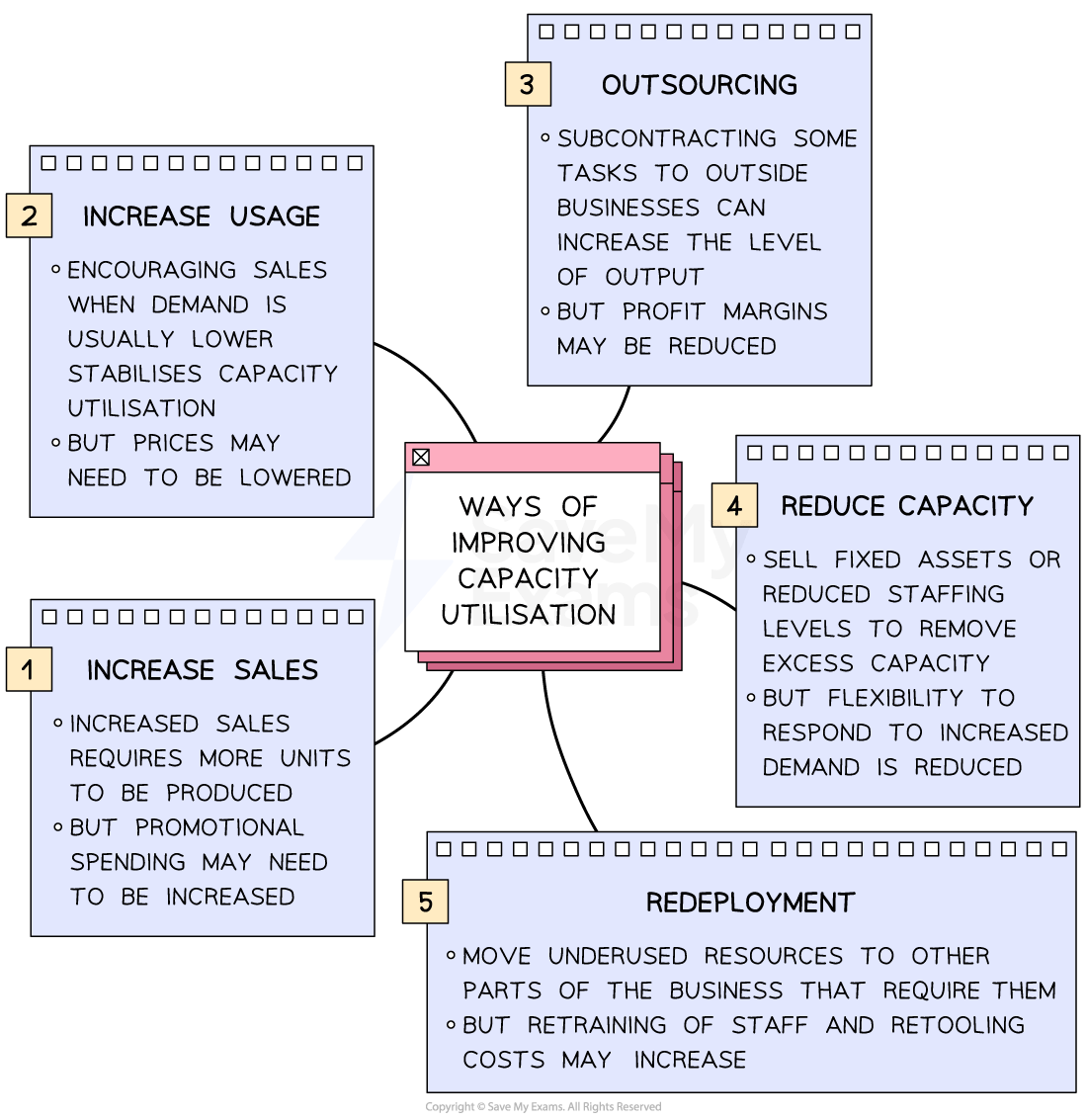Capacity Utilisation (Edexcel A Level Business): Revision Note
Exam code: 9BS0
Calculating capacity utilisation
Capacity utilisation is a measure of the level to which a business's assets are being used to produce output
It compares the current output to the maximum possible output a business can produce using all of its assets and is expressed as a percentage
Capacity utilisation is calculated using the formula
Worked Example
Lola Bakery produces specialist Indian and Bangladeshi breads that are sold to restaurants in the West Midlands. Batch production is used in the factory to manufacture a range of breads, and the factory can produce a maximum of 68,400 units per month.
In May, factory output was 51,420 units.
Calculate Lola Bakery’s capacity utilisation in May.
Step 1: Divide the current output by the maximum output
Step 2: Multiply the outcome by 100 to obtain the percentage capacity utilisation
Worked Example
Lola Bakery produces specialist Indian and Bangladeshi breads that are sold to restaurants in the West Midlands. Batch production is used in the factory to manufacture a range of breads, and the factory can produce a maximum of 68,400 units per month.
In August, capacity utilisation increased to 92%.
Calculate the number of units produced by Lola Bakery in August.
Step 1: Convert 92% to a decimal
Step 2: Find 92% of the maximum output using the decimal
Implications of underutilisation and overutilisation of capacity
Underutilisation of capacity
If a business has a low level of capacity utilisation, it will not be making the most of its resources and is likely to have increased unit costs
The fixed costs are spread over fewer units of output, resulting in higher average total costs
Workers may be underdeployed, leading to fears of redundancy
Operating under capacity does provide a business with flexibility
There may be an opportunity to engage workers in maintenance tasks
The business can respond to sudden increases in demand
Overutilisation of capacity
If a business has a high level of capacity utilisation, it may not have the flexibility to respond to new orders from customers
Staff will be under a lot of pressure to produce high levels of output
Overworked staff may be inclined to leave, increasing staff turnover
Machinery may be pushed to its limits and prone to breakdowns, which disrupts production and increases costs
High capacity utilisation will minimise average total costs and increase business competitiveness
If workers are busy, they are likely to feel secure in their employment
A business that is busy is likely to be well thought of by customers and will attract customers who are willing to wait for products to be delivered
Worked Example
Production data for pencil manufacturers A and B
Manufacturer | Current output (units) | Maximum output (units) |
|---|---|---|
A | 3m | 6m |
B | 2.4m | 4m |
Explain one implication of the level of capacity utilisation for pencil manufacturer A, compared to manufacturer B. You are advised to show your workings.
[4]
Step 1: Demonstrate knowledge of capacity utilisation
Capacity utilisation measures how well a business is using its available production capacity. [1]
Step 2: Calculate the capacity utilisation for both manufacturers
[1]
[1]
Step 3: Explain the implications
One implication is that staff may be bored and demotivated, particularly at manufacturer A, because they have less work to do than at manufacturer B. [An]
Or:
Unit costs are likely to be higher than they could be at both manufacturers [K] because resources such as workers and machinery are not being used to their full potential [An].
Examiner Tips and Tricks
Including a definition of the key term is not essential, as implicit understanding of a business term or concept can be shown through correct calculations and identifying appropriate points.
In the example above, the definition could attract a mark if calculations had not been included, but the answer achieved full marks because it included correct calculations as well as an appropriate point with an explanation.
Ways of improving capacity utilisation
Achieving an optimum level of capacity utilisation is a key production objective
A business has several options available to improve its capacity utilisation
A range of ways to improve capacity utilisation

Increasing the level of capacity utilisation results in lower unit costs
In some cases, increasing demand and thus output is the most suitable way to increase capacity utilisation
For example, reducing selling prices or offering short-term price promotions can increase demand
If competitors go out of business, demand should pick up, which will improve capacity utilisation without the need for further promotion
Reducing the level of overall capacity will improve the level of capacity utilisation
Capacity can be reduced by selling capital equipment or reducing the number of staff

Unlock more, it's free!
Did this page help you?